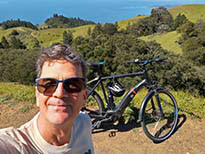* * *
As I drove up Panoramic Highway past Bootjack (headlights on and windshield wipers squeaking intermittently) I thought I'd be obliged to hang out for a while behind the locked gate since it was still 10 or 15 minutes before 7 a.m. But I pulled up and, what do you know, it was already open. Thankfully I hadn't gotten out of bed super-early to ride my bike up for the sunrise. There were no horizons in view, only a gradual disappearance of the landscape behind billowing clouds.
The rain hadn't yet begun in earnest when I arrived at Rock Spring, so I poked around among the recrudescence of mossy greens, so fresh you just knew it must be the last day of summer.
Several cars arrived shortly after I did, which surprised me due to the funky weather. Each of them drove up to the locked gate on West Ridgecrest, rethought their plans, then turned around and continued up toward East Peak.
The morning was fairly inhospitable, with gusty winds and significant fog-drip in the woods, but I was excited because I was about to check up on the trail camera I'd set up a week before. I'd hemmed and hawed for a few years before I finally decided to take a crack at camera trapping. I think this circumannuation project finally tipped the scale in favor of doing it. Although I'd much rather photograph animals in person, there's something about camera-trapping that enlivens a deep and ancient place in the heart.

While I was hiking out to the trail camera, planning to swap out memory cards and set the camera in another spot nearby, the rain began. I could hear it pelting my rain jacket, and there I was, completely exposed on Bolinas Ridge. I picked up my pace to a light jog and ducked into the lee of a couple of Douglas fir trees where I could open my umbrella without it blowing inside-out. I was trapped there for quite a while. It was 54 degrees, and I was wearing shorts, but I was also wearing a t-shirt, longjohn top, and light rain jacket -- plus I'd eaten a decent breakfast -- so I wasn't cold. I was near the trail camera, though, and eager to get going, but I bided my time and allowed myself to simply enjoy being out there.

The rain finally let up, so I continued my jog toward the trail camera, only to have it start raining again -- and I mean buckets' worth. Once again I was obliged to take cover behind some trees and park under my umbrella. By now I was too wet to simply swap out the memory cards in the field, so at the next break in the rain I jogged back to the Jeep.
I let the heater run for a while even after I drove back and parked. The rain was coming down once again, and I had to wait for a chance to retrieve the camera. When I finally went down for it, I at first didn't see it and my heart sank. "Someone took it!" But then I saw it. No one took it -- but as I found when I downloaded the pictures, it had definitely been found by passing hikers. Thanks for leaving it alone!
I set the camera in a new location that's not along an even lightly used human trail. Still no guarantee it won't be found, since lots of people hike off-trail, but hopefully it'll be okay. It would be easy enough to lock the camera to a tree, but I'm hoping that won't be necessary. I think anyone savvy enough to spot my camera is going to be cool enough to leave it in peace.
* * *




























































